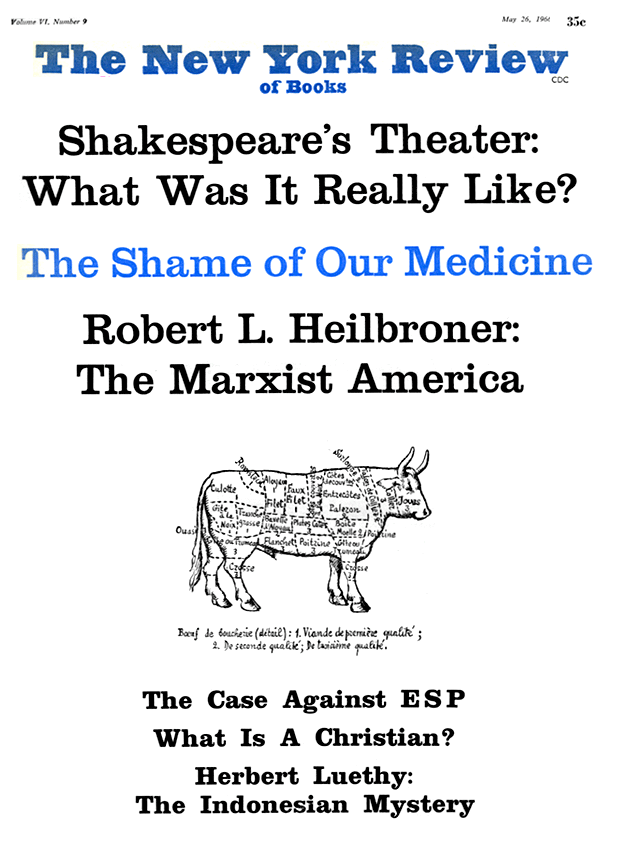In response to:
Where Do We Go From Here? from the March 17, 1966 issue
To the Editors:
If an economist were to make an analysis of (let us say) a motor corporation, and the study made no reference to the truck division or its employees, even though that division’s earnings amounted to 30 or 40 per cent of the total volume of business, we might question the economist’s conclusions.
Yet so many economists seem to be suffering presently from an equally mysterious blind spot, it would appear to be an occupational disease. Robert L. Heilbroner’s discussion of books by Herbert Simon and Robert Theobald implies that both writers have ignored one of our largest “industries”—certainly one of the largest factors in our national economy in terms of money involved—namely Education.
Heilbroner himself, in his rather detailed comments on the present and future of the national economy, also seems totally unaware of this all important and rapidly growing aspect of our economic life.
The learned gentlemen of the economics field invariably assume that the phrase “total national economy” applies only to manufacture, agriculture, and trade. To these savants, even though they are a part of it themselves, the economic effect of Education as a major employer of millions of Americans, with millions more soon to be involved as schools and colleges continue to expand and proliferate rapidly, simply does not exist.
Surely the millions of teachers, administrators, and clerical and maintenance personnel, employed by private and public schools and colleges today, must have had some bearing on unemployment caused by automation. And we know, furthermore, that the total number now employed is bound to double in not too many years, at the rate colleges are growing and new ones being created. Education is the only large-scale employer, in our present economy, wherein the unemployment problem—that obsession of all economists—is virtually nonexistent.
I wonder if Mr. Heilbroner could answer the following, at least in generally accurate terms?
(1) What percentage of the current national income is spent on maintaining public and private educational institutions?
(2) Of the total number of employed persons in the U.S., what percentage had full-time jobs in the educational institutions, in 1955; in 1965; foreseen in 1975?
Of course there are many other peripheral economic aspects of importance relating to the gigantic industry of Education. But any discussion of the national economy which omits the answers to the two questions above, might be compared to an architect’s estimate for a new house with no figures included covering labor and materials for the plumbing.
Newton F. Tolman
Marlboro, New Hampshire
Robert Heilbroner replies:
Professor Simon’s answer seems to me to fail to come to grips with my contention. Let me therefore reiterate it, as briefly as I can. He and I agree that technology has freed labor from the “food and goods” sector; and we agree furthermore, that this displaced labor has heretofore found employment in the service sector. But why there? Two reasons: first, there is where demand seems to point, particularly in an increasingly affluent society; second, there is where labor-displacing technology has been slow to enter.
My assumption is that technology is now about to enter this sector (or echelon) of tasks, again forcing an emigration of labor. Where will it go? Perhaps into still more service occupations. That is certainly a possibility that no one can deny a priori. My guess, however, is that technology will in the future be able to displace labor as effectively in this sector as it already has in the food and goods area. The remaining solutions would therefore be: (a) public (i.e., non-market) jobs, (b) by a curtailment of labor via shorter hours, earlier retirement, etc., or (c) some combination of both. I think this will happen even without a “ceiling” on total consumption, and all the more rapidly with one. And whereas I agree that the advent for such a ceiling is not imminent, I do indeed believe that a ceiling will impose itself in the longish run—say in 50 to 75 years. The world’s problem is likely to be scarcity for a long while, but not America’s problem, unless there is a change in the world-wide distribution of goods that I believe unlikely.
Perhaps I can best sum up my argument by asserting again that I believe technology does ultimately release men from the necessity of labor—meaning by this, labor that is purchased on the market. Comparing past and present, this seems to me incontrovertible: merely compare the work week in 1860 and in 1960. Projecting this trend into the future I can see severe problems for a market system, which is not to say that other modes of provisioning may not cope with the problem successfully.
With Mr. Theobald my disagreement has always been one of time-scale. I do not believe that today’s tot in “Head Start” will go to college in a radically changed environment—I wish I could believe so, but I do not; it will take longer than that. In the meanwhile—and the meanwhile is the period that occupies Professor Simon (and myself in this context)—I do not think we can introduce Guaranteed Incomes (other than in the poverty sector where I am all for them), without seriously vitiating the market system. In this vital zone where politics and economics meet, it seems to me that Mr. Theobald has always been irresponsibly vague.
As for Mr. Tolman, the answers to his questions are:
(1) about 6 per cent of GNP.
(2) roughly 2 per cent in 1960; perhaps 3-4 per cent in 1975.
This Issue
May 26, 1966


